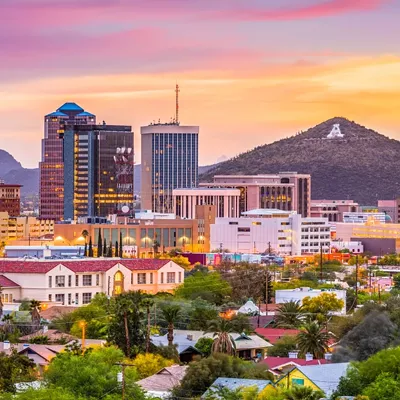"This is the reality," Babbitt said last week. "If the unrestrained development begins to affect the San Pedro River, as it will, there will be litigation. I can't tell you it's going to happen in the next eight months while I'm in office, but as sure as the sunrise, there will be litigation and a federal court will take jurisdiction of the water development in the San Pedro. A legally enforceable right was created to maintain the flow of the San Pedro River and it is going to happen unless there is a more comprehensive management plan. I don't know if it will happen in the next six months or the next six years, but in that time frame it will happen and at that point a federal judge will manage the growth of development in the San Pedro valley."
That promise pleases environmentalists fighting to preserve the West's largest natural undammed river and its critical biological areas. The San Pedro River, which flows north from Mexico into the Gila River, is one of the oldest known inhabited locations in North America. Based on evidence of mammoth hunting at the Lehner Archeological Site along the banks of the river near Hereford, people have been calling the San Pedro valley home for approximately 10,000 years.
Pumping ground water from the San Pedro basin to feed the thirsty growth of Sierra Vista, 10 miles to the west, is depleting the river and lowering the water table. The county's largest city is home to the Army's Fort Huachuca, which has been key to the city's growth to its current population of 40,000.
A 1998 report by the North American Free Trade Agreement's Commission for Environmental Cooperation said the basin is losing 7,000 acre-feet of water per year. The Arizona Department of Water Resources predicts that continued growth at the current rate would raise the deficit to 13,000 acre-feet per year by 2020. An acre-foot of water equals approximately 326,000 gallons.
Sierra Vista Mayor Tom Hessler bristled at Babbitt's comments. "That's true to form," Hessler said. "The city manager and I met with Secretary Babbitt privately several months ago where he all but threatened that if we don't do something, they're going to come in and do it for us. We are managing it and we are good stewards. We're being held hostage in our ability to increase our quality of life and provide jobs."
The military base has established conservation efforts and reduced its water use. The city has also embarked on a sewage recharge project to put water back into the basin.
"Those two projects alone could probably mitigate water use for years to come, if they are successful," Hessler said.
Critics say that's not nearly enough, since the city and county have done little to manage overall growth.
"I don't want to say they are doing nothing," said Kieran Suckling, executive director for the Center for Biological Diversity. "But there is very little political will on the part of the county or the city to take any of the really hard steps. They aren't even close to being adequate on this. Without water rights, the whole conservation area is going to die if something doesn't happen soon. Unless there's major reform in water use in the basin, the conservation area will be wiped out within a few decades."
The Center for Biological Diversity has called for closing Fort Huachuca as a way of halting growth in Sierra Vista. That would not only halt growth, but would devastate the town economically, since the base is the region's largest employer and the county's main economic engine. The base has 11,700 military and civilian employees.
Babbitt said he wasn't calling for a no-growth policy, but would like to see some planning.
"The environmentalists tend to get sidetracked into the no-growth thing," Babbitt said. "Here I think is the difference between them and me. To the extent that they're saying 'no growth,' I'm saying that's not my position. There's room for growth if we will make intelligent decisions about how it is we use water and have the foresight to manage water use, to view it as a scarce commodity."
Babbitt added, "The time is at hand for a comprehensive growth management plan. There is room for growth, but the water development must be accompanied by conservation measures, by the placement of development away from the river and retiring agricultural uses to offset the demand on the aquifer. The random quality of what's going on in that valley is pretty discouraging."
Among the major players in Sierra Vista's growth is Castle & Cooke, a massive development company which started in Hawaii in 1851. The company is the largest developer in the area and plans to build as many as 20,000 new homes.
That has Babbitt concerned.
"It's uncertain what Castle and Cooke's plans are for the San Pedro and whether they are going to do this by overrunning and exhausting the water supplies or if they are going to attempt to come to terms with the physical realities of the San Pedro River valley," he said.
"Castle & Cooke has been a great asset to the community," Hessler retorted. "They've allowed us to grow quality-wise for many years. Like any developer, they get blamed for a lot of things. But they've never done anything that the city didn't allow them to do."
The city tried to put together an annexation agreement a year ago that would have brought all of Castle & Cooke's properties within the city boundries. A voter referendum on annexation scheduled for November, however, halted that process.
Meanwhile, another company is planning a $2-billion resort and homes for more than 1,000 new residents on the eastern side of the river outside of Tombstone, which only has 1,400 residents currently.
"What's scary is that Tucson had 40,000 people in the 1940s and we had a river that looked a lot like the San Pedro," said Suckling. "Now the Santa Cruz River is dead as a doornail. The political leaders in Sierra Vista are saying they'll never grow to the size of Tucson, but there's absolutely nothing to stop it, and the San Pedro will look like the Santa Cruz. It will be a ditch."









